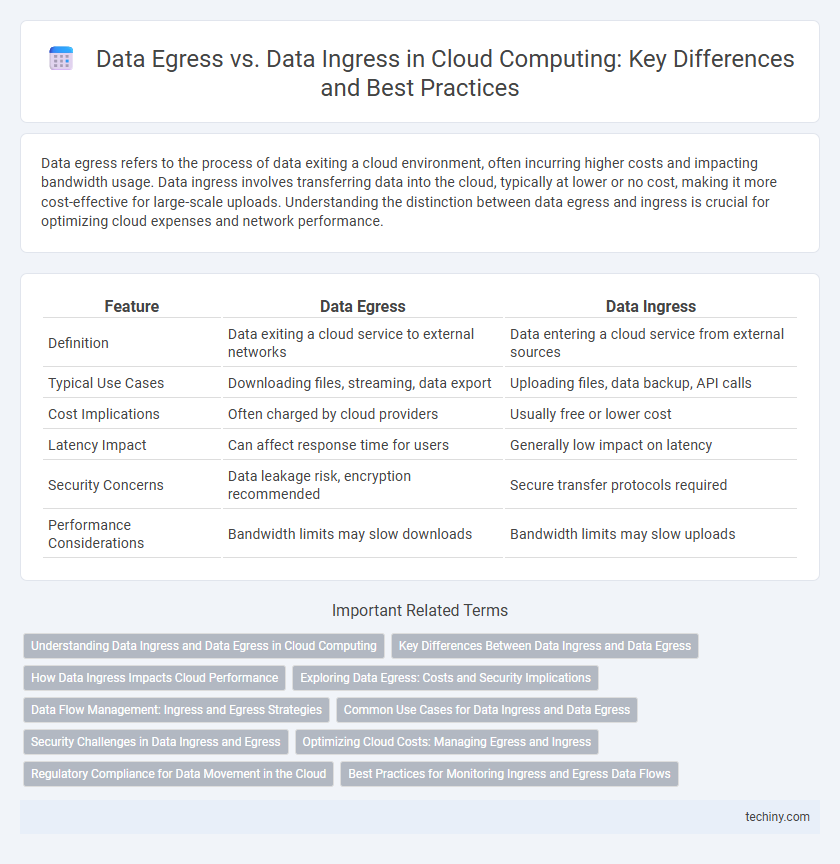Data egress refers to the process of data exiting a cloud environment, often incurring higher costs and impacting bandwidth usage. Data ingress involves transferring data into the cloud, typically at lower or no cost, making it more cost-effective for large-scale uploads. Understanding the distinction between data egress and ingress is crucial for optimizing cloud expenses and network performance.
Table of Comparison
| Feature | Data Egress | Data Ingress |
|---|---|---|
| Definition | Data exiting a cloud service to external networks | Data entering a cloud service from external sources |
| Typical Use Cases | Downloading files, streaming, data export | Uploading files, data backup, API calls |
| Cost Implications | Often charged by cloud providers | Usually free or lower cost |
| Latency Impact | Can affect response time for users | Generally low impact on latency |
| Security Concerns | Data leakage risk, encryption recommended | Secure transfer protocols required |
| Performance Considerations | Bandwidth limits may slow downloads | Bandwidth limits may slow uploads |
Understanding Data Ingress and Data Egress in Cloud Computing
Data ingress in cloud computing refers to the transfer of data into cloud storage or services, typically involving uploading files or streaming data from on-premises systems to the cloud. Data egress, on the other hand, involves the transfer of data out of the cloud to local environments or other cloud services, often incurring higher costs due to outbound bandwidth usage. Understanding these concepts is essential for optimizing cloud architecture to manage bandwidth effectively, minimize expenses, and ensure efficient data flows between cloud and on-premises systems.
Key Differences Between Data Ingress and Data Egress
Data ingress refers to the process of transferring data into a cloud environment, typically involving upload operations from local systems to cloud storage. Data egress involves the movement of data out of the cloud, often incurring higher costs due to bandwidth usage and is critical for data retrieval or migration. Key differences include cost implications, with egress usually being more expensive, and security considerations, as ingress data must be validated while egress data requires secure transmission protocols.
How Data Ingress Impacts Cloud Performance
Data ingress, the process of transferring data into the cloud, directly influences cloud performance by affecting network bandwidth and latency. High volumes of inbound data can create bottlenecks, leading to slower application response times and increased resource consumption. Efficient data ingress strategies, such as optimizing upload protocols and leveraging edge computing, help maintain seamless cloud performance and reduce operational costs.
Exploring Data Egress: Costs and Security Implications
Data egress in cloud computing refers to the transfer of data from cloud services to external locations, often incurring significant costs due to bandwidth usage and cloud provider pricing models. Understanding egress fees is crucial for budgeting, as outbound data transfers typically cost more than inbound data ingress. Security implications include the risk of data exposure during transfer and the need for robust encryption and access controls to protect sensitive information leaving the cloud environment.
Data Flow Management: Ingress and Egress Strategies
Data flow management in cloud computing requires balancing data ingress and egress to optimize performance and costs. Effective ingress strategies prioritize secure, efficient data upload to cloud storage, minimizing latency and bandwidth consumption. Egress strategies focus on controlling outbound data transfer, leveraging techniques like caching and data compression to reduce egress fees and enhance user experience.
Common Use Cases for Data Ingress and Data Egress
Data ingress commonly occurs during cloud migration when enterprises upload large datasets from on-premises storage to cloud environments for analytics, backup, or disaster recovery. Data egress is frequently observed in content delivery scenarios where multimedia files are streamed from cloud servers to end-users, incurring bandwidth charges based on outbound data transfer. Backup restorations and hybrid cloud architectures also generate significant data egress as applications retrieve or synchronize data from cloud storage back to on-premises systems.
Security Challenges in Data Ingress and Egress
Data ingress and egress in cloud computing present critical security challenges, including unauthorized access, data leakage, and interception risks during transmission. Ensuring robust encryption protocols, strict access controls, and continuous monitoring are essential to safeguard sensitive information entering and exiting cloud environments. Misconfigured ingress points and insufficient egress filtering can lead to data breaches and compliance violations, emphasizing the need for comprehensive security strategies.
Optimizing Cloud Costs: Managing Egress and Ingress
Data egress and ingress in cloud computing directly impact overall cloud costs, with egress typically incurring higher fees due to outbound data transfer charges from cloud providers like AWS, Azure, and Google Cloud. Efficiently managing data ingress through streamlined uploads and minimizing egress by compressing or caching data reduces unnecessary transfer costs and optimizes cloud expenses. Implementing policies such as data lifecycle management, using Content Delivery Networks (CDNs), and choosing regions with lower egress rates are pivotal strategies for cost-effective cloud data management.
Regulatory Compliance for Data Movement in the Cloud
Data egress and data ingress in cloud computing are critical factors for regulatory compliance, as they govern the movement of sensitive information across geographic boundaries. Organizations must ensure that data egress complies with local data sovereignty laws such as GDPR in Europe or CCPA in California, which restrict cross-border data transfers without proper safeguards. Implementing encryption, access controls, and audit trails during both data ingress and egress processes helps meet compliance requirements and mitigate legal risks associated with unauthorized data movement in the cloud.
Best Practices for Monitoring Ingress and Egress Data Flows
Effective monitoring of data ingress and egress in cloud computing environments involves implementing automated tools that track data transfer patterns and volume in real time to detect anomalies or unauthorized access. Employing granular access controls and encryption for both inbound and outbound data ensures secure and compliant data flow management. Regular audits combined with detailed logging provide visibility into data movement, helping optimize bandwidth usage and reduce latency while maintaining adherence to regulatory requirements.
Data Egress vs Data Ingress Infographic

 techiny.com
techiny.com